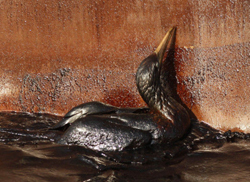
Photo by: www.huffingtonpost.com
Article by: Heather Ishimaru
BERKELEY, CA (KGO) -- Once the Gulf Coast oil spill is contained, the next problem will be how to clean it up.
Lawrence Berkeley National Laboratory's Ecology Department is led by Terry Hazen, who says after picking up as much oil as possible, "exercise extreme caution about whatever else you do."
Hazen has more than 30 years experience studying the effects of oil spills. He says the oil will be damaging enough; toxic dispersants will just make it worse. He points to the 1978 Amoco Cadiz Spill off the coast of Normandy as an example. He says areas where dispersants were used still have not fully recovered, while areas where there was no human intervention are now fine.
Hazen says oil is a biological, biodegradable product. In the Gulf alone, oil naturally seeps at a rate of twice the Exxon Valdez spill every year, and nature takes care of it.
"There are no magic bugs, no magic foo-foo dust, we should just rely on the environment to do what it can do best," he said.
There are scenarios where a dispersant might be called for, like if an endangered species is at risk from the short-term effects of a spill.
Thomas Azwell is a doctoral candidate at UC Berkeley's College of Natural Resources. He designed an organic cleaning process used in the Cosco Busan spill. Natural fiber mats are used to collect the oil, then earthworms eat the microbes. The result is worm waste that can be used as fertilizer -- 10 cubic yards of it ended up on Presidio landscaping.
Azwell worked on off-shore oil rigs before his academic career.
He does not plan to seek a patent for his process; he just wants to provide a solution available to everyone.
"So if I really want to scale this and I really want this to disseminate across, not only geographical, but economical borders, then I would need this to be free," Azwell said.
Hazen and a team from the Lawrence Berkeley Lab could soon be on their way to the Gulf. It would be a research trip, possibly in collaboration with University of Alabama, Florida State University, Gulf Coast Research Lab (Southern Mississippi University), Louisiana State University, the DOE and BP.
